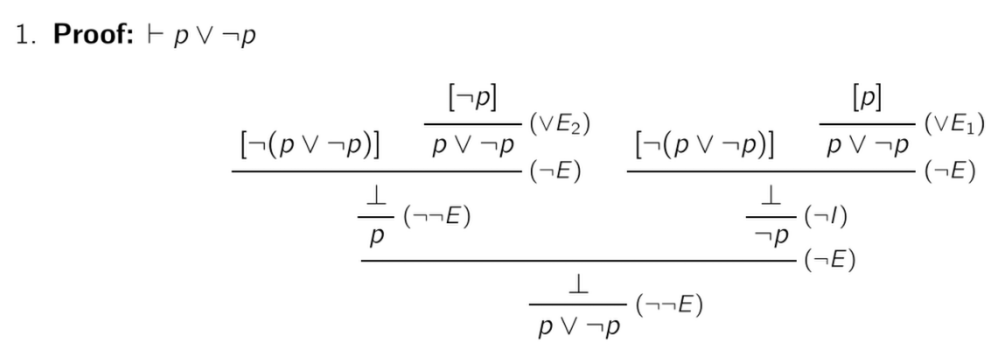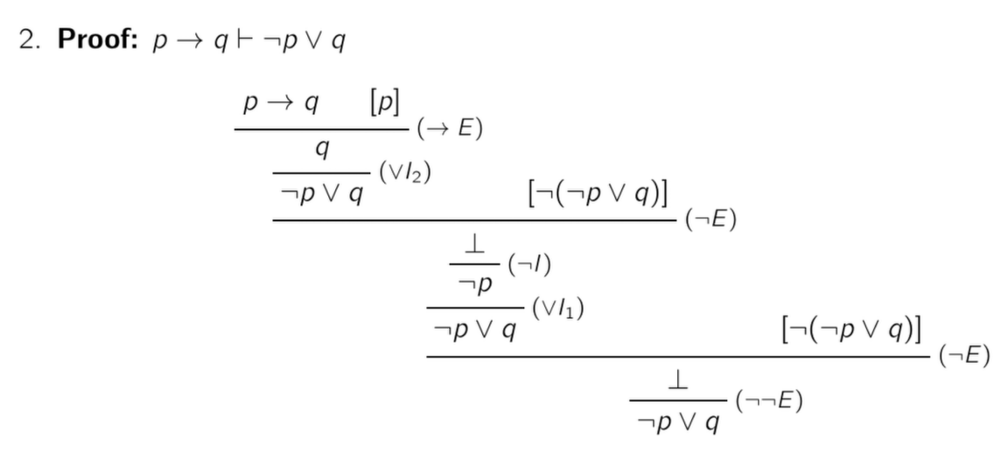Tutorial 7. Logical proofs
Exercise sheet
Hilbert systems
Provide derivations in our Hilbert system for the following provability claims:
a) Easier
- $\neg p\to (p\to p)$
- $\vdash q\to (p\lor q)$
- $p\to q,q\to r\vdash p\to r$
b) Harder
- $\vdash \neg\neg p\to p$
- $\vdash p\to (p\lor q)$
- $\vdash (p\land q)\to p$
Hint: It’s generally advisable to derive auxiliary laws along the way. You may always use claims proved earlier, such as $\vdash p\to p$ in a derivation.
Advice: These can be really hard, but perseverance is the key. If you can’t get them all, don’t worry. We won’t test your expertise with the Hilbert system.
Solution
a) Easier
Proof: $\vdash\neg p\to(p\to p)$
- $p\to p\quad$ (Use proof strategy for $\vdash\phi\to\phi$)
- $(p\to p)\to(\neg p\to(p\to p))\quad$ (Axiom 1)
- $\neg p\to(p\to p)\quad$ (MP, 5, 6)
Proof: $\vdash q\to(p\lor q)$
- $q\to(\neg p\to q)\quad$ (Axiom 1)
- $q\to(p\lor q)\quad$ (Rewriting $(\neg p\to q)$ as $(p\lor q)$)
Proof: $p\to q,q\to r\vdash p\to r$
- $p\to q\quad$ (Assumption)
- $q\to r\quad$ (Assumption)
- $(q\to r)\to(p\to(q\to r))\quad$ (Axiom 1)
- $p\to(q\to r)\quad$ (MP, 3, 4)
- $(p\to(q\to r))\to((p\to q)\to(p\to r))\quad$ (Axiom 2)
- $(p\to q)\to(p\to r)\quad$ (MP, 4, 5)
- $p\to r\quad$ (MP, 1, 6)
b) Harder
Proof: $\vdash\neg\neg p\to p$
- $\neg\neg p\to \neg\neg p\quad$ (Use proof strategy for $\vdash\phi\to\phi$)
- $\neg\neg p\to(\neg\neg\neg\neg p\to\neg\neg p)\quad$ (Axiom 1)
- $(\neg\neg\neg\neg p\to\neg\neg p)\to(\neg p\to\neg\neg\neg p)\quad$ (Axiom 3)
- $\neg\neg p\to(\neg p\to\neg\neg\neg p)\quad$ (Use proof strategy for $\phi\to\psi,\psi\to\chi\vdash\phi\to\chi$ on 2,3)
- $(\neg p\to\neg\neg\neg p)\to(\neg\neg p\to p)\quad$ (Axiom 3)
- $\neg\neg p\to(\neg\neg p\to p)\quad$ (Use proof strategy for $\phi\to\psi,\psi\to\chi\vdash\phi\to\chi$ on 4,5)
- $(\neg\neg p\to(\neg\neg p\to p))\to((\neg\neg p\to\neg\neg p)\to(\neg\neg p\to p))\quad$ (Axiom 2)
- $(\neg\neg p\to\neg\neg p)\to(\neg\neg p\to p)\quad$ (MP, 6, 7)
- $\neg\neg p\to p\quad$ (MP, 1, 8)
Proof: $\vdash p\to(p\lor q)$
- $p\to(\neg q\to p)\quad$ (Axiom 1)
- $\neg\neg\neg p\to\neg p\quad$ (Use proof strategy for $\vdash\neg\neg\phi\to\phi$)
- $(\neg\neg\neg p\to\neg p)\to(p\to\neg\neg p)\quad$ (Axiom 3)
- $p\to\neg\neg p\quad$ (MP, 2, 3)
- $(p\to\neg\neg p)\to(\neg q\to(p\to\neg\neg p))\quad$ (Axiom 1)
- $\neg q\to(p\to\neg\neg p)\quad$ (MP, 4, 5)
- $(\neg q\to(p\to\neg\neg p))\to((\neg q\to p)\to(\neg q\to\neg\neg p))\quad$ (Axiom 2)
- $(\neg q\to p)\to(\neg q\to\neg\neg p)\quad$ (MP, 6, 7)
- $p\to(\neg q\to\neg\neg p)\quad$ (Use proof strategy for $\phi\to\psi,\psi\to\chi\vdash\phi\to\chi$ on 1,8)
- $(\neg q\to\neg\neg p)\to(\neg p\to q)\quad$ (Axiom 3)
- $p\to(\neg p\to q)\quad$ (Use proof strategy for $\phi\to\psi,\psi\to\chi\vdash\phi\to\chi$ on 9,10)
- $p\to(p\lor q)\quad$ (Rewriting $(\neg p\to q)$ as $(p\lor q)$)
Proof: $\vdash(p\land q)\to p$
- $\neg p\to(q\to\neg p)\quad$ (Axiom 1)
- $\neg\neg q\to q\quad$ (Use proof strategy for $\vdash\neg\neg\phi\to\phi$)
- $(\neg\neg q\to q)\to(\neg p\to(\neg\neg q\to q))\quad$ (Axiom 1)
- $\neg p\to(\neg\neg q\to q)\quad$ (MP, 2, 3)
- $(q\to\neg p)\to(\neg\neg q\to(q\to\neg p))\quad$ (Axiom 1)
- $\neg p\to(\neg\neg q\to(q\to\neg p))\quad$ (Use proof strategy for $\phi\to\psi,\psi\to\chi\vdash\phi\to\chi$ on 1,5)
- $(\neg\neg q\to(q\to\neg p))\to((\neg\neg q\to q)\to(\neg\neg q\to\neg p))\quad$ (Axiom 2)
- $\neg p\to((\neg\neg q\to q)\to(\neg\neg q\to\neg p))\quad$ (Use proof strategy for $\phi\to\psi,\psi\to\chi\vdash\phi\to\chi$ on 6,7)
- $(\neg p\to((\neg\neg q\to q)\to(\neg\neg q\to\neg p)))\to((\neg p\to(\neg\neg q\to q))\to(\neg p\to(\neg\neg q\to\neg p)))\quad$ (Axiom 2)
- $(\neg p\to(\neg\neg q\to q))\to(\neg p\to(\neg\neg q\to\neg p))\quad$ (Use proof strategy for $\phi\to\psi,\psi\to\chi\vdash\phi\to\chi$ on 8,9)
- $\neg p\to(\neg\neg q\to\neg p)\quad$ (MP, 4, 10)
- $(\neg\neg q\to\neg p)\to(p\to\neg q)\quad$ (Axiom 3)
- $\neg p\to(p\to\neg q)\quad$ (Use proof strategy for $\phi\to\psi,\psi\to\chi\vdash\phi\to\chi$ on 11,12)
- $\neg\neg\neg(p\to\neg q)\to\neg(p\to\neg q)\quad$ (Use proof strategy for $\vdash\neg\neg\phi\to\phi$)
- $(\neg\neg\neg(p\to\neg q)\to\neg(p\to\neg q))\to((p\to\neg q)\to\neg\neg(p\to\neg q))\quad$ (Axiom 3)
- $(p\to\neg q)\to\neg\neg(p\to\neg q)\quad$ (MP, 15, 16)
- $\neg p\to\neg\neg(p\to\neg q)\quad$ (Use proof strategy for $\phi\to\psi,\psi\to\chi\vdash\phi\to\chi$ on 13,16)
- $(\neg p\to\neg\neg(p\to\neg q))\to(\neg(p\to\neg q)\to p)\quad$ (Axiom 2)
- $\neg(p\to\neg q)\to p\quad$ (MP, 17, 18)
- $(p\land q)\to p\quad$ (Rewriting $(\neg(p\to\neg q))$ as $(p\land q)$)
Natural deduction systems
Provide derivations in our natural system for the following provability claims:
a) Easier
Only 3.,5., and 6. as homework.
- $p\vdash p\lor (p\land q)$
- $p\lor (p\land q)\vdash p$
- $p\lor q\vdash q\lor p$
- $p\land q\vdash q\land p$
- $\neg p,p\lor q\vdash q$
- $\neg p\lor \neg q\vdash \neg(p\land q)$
b) Harder
- $\vdash p\lor\neg p$
- $p\to q\vdash \neg p\lor q$
- $\neg(p\land q)\vdash \neg p\lor\neg q$
Solution
a)






b)



Lean
For this exercise, you can use the live Lean 4 environment, which is available onlien here .
Lean is a full fledged programming language, so we can’t reasonably learn it completely in just one session. What I’d like you to do, though is to experiment a bit with it. If you want to learn more and have some time, you can read more details in this fantastic book , especially chapter 3 and chapter 5 .
Before we begin a bit of explanation. In the following, we’ll provide copy-paste-able code that you can run directly in the environment.
Here is the first snippet, which declares $p,q,r$ as variables for propositions:
$\mathsf{L}\exists\forall \mathsf{N}$ snippet (click to expand)
variable {p : Prop}
variable {q : Prop}
variable {r : Prop}
This should be at the beginning of any piece of code you run from below.
Lean has several modes. We will only use the so-called “tactic” mode. It’s a simplified version of Lean that makes Lean-proofs work more like natural deduction proofs.
This is easiest shown with an example. Consider the following natural deduction proof showing that
$$\vdash p\to p\land (p\lor q)$$
which is known as an absorption law:

Effectively, we assume $p$ (twice) for $\to I$ and then we derive $p\lor q$ from one assumption via $\lor I$ and then from this and the second assumption that $p$ that $p\land (p\lor q)$ via $\land I$.
Here’s how this proof in Lean:
$\mathsf{L}\exists\forall \mathsf{N}$ snippet (click to expand)
theorem absorption_conj : p → (p ∧ (p ∨ q)) := by
intro hypothesis_p -- Hypothesis for conditional proof
apply And.intro -- When this completes we have proven (p ∧ (p ∨ q))
exact hypothesis_p -- This is (trivial proof of) p
apply Or.inl hypothesis_p -- Here we prove (p ∨ q)
We first declare that we’re proving a theorem and we call it
absorption_conj. Then comes the statement of the theorem. To obtain
$\to,\land,\lor$ in Lean, you can write \to, \and, \or,
respectively.
We then apply the tactics:
-
introintroduces an assumption for conditional proof ($\to I$), and we call ithypothesis_p. -
And.introis essentially $\land I$.apply And.introapplies the rule to the next two complete proofs. -
exact hypothesis_pmeans to precisely apply the hypothesis that $p$, which is the first input for theAnd.intro. -
Or.inlis the rule $p\vdash p\lor q$ andOr.inrthe rule $q\vdash p\lor q$. Here we apply the rule to the assumption that $p$hypothesis_p, which gives us what we need, viz. $p\lor q$.
This completes our proof. The result should look something like this in your browser:

No errors means we’re good!
One more example for an important concept:
$\mathsf{L}\exists\forall \mathsf{N}$ snippet (click to expand)
theorem commutativity_or : (p ∨ q) → (q ∨ p) := by
intro hypothesis_pORq
apply Or.elim hypothesis_pORq
· intro hypothesis_p
apply Or.inr hypothesis_p
· intro hypothesis_q
apply Or.inl hypothesis_q
This is the following natural deduction proof:

The $\bullet$ mark the two sub-proofs for the $\lor E$, where we derive $q\lor
p$ from the two assumptions $p$ and $q$. Note that each proof after
Or.elim is a conditional proof: we first show that $p\to q\lor p$ and then
we show that $q\to q\lor p$. This allows us to infer $q\lor p$ from $p\lor q$.
You can write the bullet points in Lean as \..
Let’s see if this is enough. It’s your turn:
The basic tactics are:
intro(followed by hypothesis name)And.intro(followed by two proofs for the conjuncts)And.left(infers the left conjunct from the conjunction)And.right(infers the right conjunct from the conjunction)Or.inl(infers the disjunction from the left disjunct)Or.inr(infers the disjunction from the right disjunct)Or.elim(disjunction elimination is followed by two conditional proofs, one for each disjunct)
a)
Translate the following LEAN proof into natural deduction:
$\mathsf{L}\exists\forall \mathsf{N}$ snippet (click to expand)
theorem some_law : (p ∧ q) → (p ∨ q) := by
intro h
apply Or.inl
exact And.left h
b)
Which tactics should be used where I wrote ????
$\mathsf{L}\exists\forall \mathsf{N}$ snippet (click to expand)
example (p q r : Prop) : p ∧ (q ∨ r) → (p ∧ q) ∨ (p ∧ r) := by
??? h
apply Or.elim (And.right h)
. intro hq
apply Or.inl
apply And.intro
. exact ??? h
. exact hq
. intro hr
apply Or.inr
apply ???
. exact And.left h
. exact hr
c)
Give a Lean proof for $\vdash p\lor (p\land q)\to p$ (absorption_disj).
Solution
a) translating into natural deduction (you get the idea)
| $p\land q$ |
|---|
| $p$ |
| $p\lor q$ |
b) finishing the proof
$\mathsf{L}\exists\forall \mathsf{N}$ snippet (click to expand)
example (p q r : Prop) : p ∧ (q ∨ r) → (p ∧ q) ∨ (p ∧ r) := by
intro h
apply Or.elim (And.right h)
. intro hq
apply Or.inl
apply And.intro
. exact And.left h
. exact hq
. intro hr
apply Or.inr
apply And.intro
. exact And.left h
. exact hr
c) constructing a lean proof
$\mathsf{L}\exists\forall \mathsf{N}$ snippet (click to expand)
variable {p : Prop}
variable {q : Prop}
variable {r : Prop}
theorem absorption_disj : (p ∨ (p ∧ q)) → p := by
intro hyp_disj
apply Or.elim hyp_disj
· intro hyp_p
exact hyp_p
· intro hyp_pnq
apply And.left hyp_pnq
Research
Are the basic tactics enough to prove classical laws, like $\vdash p\lor \neg p$?
Discussion
Recent LLM-technologies, like ChatGTP o1-preview, have impressive
reasoning capabilities. So, these LLMs can directly produce mathematical proofs.
Does this show that neural theorem proving using tools like Lean is unnecessary?